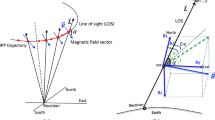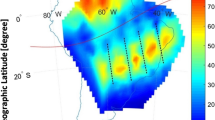Abstract
The propagation paths of signals through equatorial ionospheric irregularities are analyzed by evaluating their effects on Global Navigation Satellite System (GNSS) positioning and availability. Based on observations during 32 days by a scintillation monitor at São José dos Campos, Brazil, it was noted that there is a dominance of enhanced scintillation events for Global Positioning System (GPS) ray paths aligned with the azimuth angle of 345° (geographic northwest). This azimuth corresponds to the magnetic meridian that has a large westward declination angle in the region (21.4ºW). Such results suggest that the enhanced scintillation events were associated with GPS signals that propagated through plasma bubbles aligned along the direction of the magnetic field. It will be shown that, under this alignment condition, the longer propagation path length through plasma bubbles can result in more severe scintillation cases and more losses of signal lock, as supported by proposed statistics of bit error probability and mean time between cycle slips. Additionally, large precise positioning errors are also related to these events, as demonstrated by precise point positioning experiments.









Similar content being viewed by others
References
Abdu MA, Bittencourt JA, Batista IS (1981) Magnetic declination control of the equatorial F region dynamo electric field development and spread F. J Geophys Res 86(13):11443–11446. https://doi.org/10.1029/JA086iA13p11443
Abdu MA, Kherani EA, Batista IS, de Paula ER, Fritts DC, Sobral JHA (2009) Gravity wave initiation of equatorial spread F/plasma bubble irregularities based on observational data from the SpreadFEx campaign. Ann Geophys 27(7):2607–2622. https://doi.org/10.5194/angeo-27-2607-2009
Abdu MA, Brum CGM, Batista PP, Gururbaran S, Pancheva D, Bageston JV, Batista IS, Takahashi H (2015) Fast and ultrafast Kelvin wave modulations of the equatorial evening F region vertical drift and spread F development. Earth Planets Space 67(1):1–15. https://doi.org/10.1186/s40623-014-0143-5
Basu S, Basu S (1981) Equatorial scintillations—a review. J Atmos Terr Phys 43(5–6):473–489. https://doi.org/10.1016/0021-9169(81)90110-0
Blewitt G (1990) An automatic editing algorithm for GPS data. Geophys Res Lett 17(3):199–202. https://doi.org/10.1029/GL017i003p00199
DasGupta A, Ray S, Paul A, Banerjee P, Bose A (2004) Errors in position-fixing by GPS in an environment of strong equatorial scintillations in the Indian zone. Radio Sci, 39(1), https://doi.org/10.1029/2002RS002822
de Paula ER, Jonah OF, Moraes AO, Kherani EA, Fejer BG, Abdu MA, Muella MTAH, Batista IS, Dutra SLG, Paes RR (2015) Low-latitude scintillation weakening during sudden stratospheric warming events. J Geophys Res 120(3):2212–2221. https://doi.org/10.1002/2014JA020731
Doherty PH, Delay SH, Valladares CE, Klobuchar JA (2004) Ionospheric scintillation effects on GPS in the equatorial and auroral regions. J Inst of Navig 50(4):235–246. https://doi.org/10.1002/j.2161-4296.2003.tb00332.x
El Ayadi MMH, Ismail MH (2014) Novel closed-form exact expressions and asymptotic analysis for the symbol error rate of single- and multiple-branch MRC and EGC receivers over α–µ fading. IEEE Trans Veh Technol 63(9):4277–4291. https://doi.org/10.1109/TVT.2014.2316418
Gao Y, Shen X (2002) A new method for carrier-phase-based precise point positioning. J Inst Navig 49(2):109–116. https://doi.org/10.1002/j.2161-4296.2002.tb00260.x
Humphreys TE, Psiaki ML, Hinks JC, O’Hanlon B, Kintner PM (2009) Simulating ionosphere-induced scintillation for testing GPS receiver phase tracking loops. IEEE J Sel Top Signal Process 3(4):707–715. https://doi.org/10.1109/JSTSP.2009.2024130
Humphreys TE, Psiaki ML, Ledvina BM, Cerruti AP, Kintner PM (2010a) Data-driven testbed for evaluating GPS carrier tracking loops in ionospheric scintillation. IEEE Trans Aerosp Electron Syst 46(4):1609–1623. https://doi.org/10.1109/TAES.2010.5595582
Humphreys TE, Psiaki ML, Kintner PM Jr (2010b) Modeling the effects of ionospheric scintillation on GPS carrier phase tracking. IEEE Trans Aerosp Electron Syst 46(4):1624–1637. https://doi.org/10.1109/TAES.2010.5595583
Kintner PM, Kil H, Beach TL, de Paula ER (2001) Fading timescales associated with GPS signals and potential consequences. Radio Sci 36(4):731–743. https://doi.org/10.1029/1999RS002310
Kintner PM, Ledvina BM, de Paula ER (2007) GPS and ionospheric scintillations. Space Weather 5(9):1–23. https://doi.org/10.1029/2006SW000260
Magableh AM, Matalgah MM (2009) Moment generating function of the generalized α–µ distribution with applications. IEEE Commun Lett 13(6):411–413. https://doi.org/10.1109/LCOMM.2009.090339
Marques HA, Monico JFG, Shimabukuro MH, Oyama RT, Wentz JP (2014) Real time PPP: fundamentals, computational implementation and results analysis for static and kinematic mode. Braz Cartogr Mag 6(66):1331–1345
Marques HAS, Monico JFG, Marques HA (2016) Performance of the L2C civil GPS signal under various ionospheric scintillation effects. GPS Solut 20(2):139–149. https://doi.org/10.1007/s10291-015-0472-2
Moraes AO, de Paula ER, Perrella WJ, Rodrigues FS (2012) On the distribution of GPS signal amplitudes during the low-latitude ionospheric scintillation. GPS Solut 17(4):499–510. https://doi.org/10.1007/s10291-012-0295-3
Moraes AO, de Paula ER, Muella MTAH, Perrella WJ (2014a) On the second order statistics for GPS ionospheric scintillation modeling. Radio Sci 49(2):94–105. https://doi.org/10.1002/2013RS005270
Moraes AO, Costa E, de Paula ER, Perrella WJ, Monico JFG (2014b) Extended ionospheric amplitude scintillation model for GPS receivers. Radio Sci 49(5):315–333. https://doi.org/10.1002/2013RS005307
Moraes AO, Costa E, Abdu MA, Rodrigues FS, de Paula ER, Oliveira K, Perrella WJ (2017) The variability of low-latitude ionospheric amplitude and phase scintillation detected by a triple-frequency GPS receiver. Radio Sci 52(4):439–460. https://doi.org/10.1002/2016RS006165
Moreno B, Radicella S, de Lacy MC, Herraiz M, Rodriguez-Caderot G (2011) On the effects of the ionospheric disturbances on precise point positioning at equatorial latitudes. GPS Solut 15(4):381–390. https://doi.org/10.1007/s10291-010-0197-1
Ray S, Bhowmik U, Das A (2014) Scintillation effects related to propagation geometry as applicable to Indian SBAS. In: Proceedings of the XXXI URSI General Assembly and Scientific Symposium, paper 1463. Beijing
Sobral JHA, Abdu MA, Takahashi H, Taylor MJ, de Paula ER, Zamlutti CJ, Aquino MG, Borba GL (2002) Ionospheric plasma bubble climatology over Brazil based on 22 years (1977–1998) of 630 nm airglow observations. J Atmos Sol Terr Phys 64(12–14):1517–1524. https://doi.org/10.1016/S1364-6826(02)00089-5
Teunissen PJG (1998) Quality control and GPS. In: Teunissen PJG, Kleusberg A (eds) GPS for geodesy, 2nd edn. Springer, Berlin, pp 271–318
Thébault E et al (2015) International geomagnetic reference field: the 12th generation. Earth Planets Space 67:1–19. https://doi.org/10.1186/s40623-015-0228-9. 79
Tsunoda RT (1985) Control of the seasonal and longitudinal occurrence of equatorial scintillations by the longitudinal gradient in integrated E region PedersEn conductivity. J Geophys Res 90(A1):447–456. https://doi.org/10.1029/JA090iA01p00447
Vani BC, Shimabukuro MH, Monico JFG (2016) Visual exploration and analysis of ionospheric scintillation monitoring data: the ISMR query tool. Comp Geosc 104:125–134. https://doi.org/10.1016/j.cageo.2016.08.022
Xu R, Liu Z, Li M, Morton Y, Chen W (2012) An analysis of low-latitude ionospheric scintillation and its effects on precise point positioning. J Global Position Syst 11(1):22–32. https://doi.org/10.5081/jgps.11.1.22
Yacoub MD (2007) The α-µ distribution: A physical fading model for the Stacy distribution. IEEE Trans Veh Technol 56(1):27–34. https://doi.org/10.1109/TVT.2006.883753
Yeh KC, Liu CH (1982) Radio wave scintillations in the ionosphere. Proceedings of the IEEE, 70(4):324–360, https://doi.org/10.1109/PROC.1982.12313
Zhang X, Guo F, Zhou P (2014) Improved precise point positioning in the presence of ionospheric scintillation. GPS Solut 18(1):51–60. https://doi.org/10.1007/s10291-012-0309-1
Zumberge JF, Heflin MB, Jefferson DC, Watkins MM, Webb FH (1997) Precise point positioning for the efficient and robust analysis of GPS data from large networks. J Geophys Res 102(B3):5005–5017. https://doi.org/10.1029/96JB03860
Acknowledgements
This work is supported by Conselho Nacional de Desenvolvimento Científico e Tecnológico (CNPq) under award number (INCT) 465648/2014-2 and FAPESP 2017/50115-0. B. C. Vani thanks Federal Institute of Education, Science and Technology of Sao Paulo (IFSP) for supporting his Ph.D. research and Coordenação de Aperfeiçoamento de Pessoal de Nível Superior (CAPES) for Grant (CAPES/PDSE no. 19-2016/Process n. 88881.134266/2016-01). M. A. Abdu acknowledges the CAPES support for a senior visiting professorship at ITA/DCTA. E. Costa is supported by CNPq award number (PQ) 309013/2016-0. E. R. de Paula is supported by CNPq award number (PQ) 310802/2015-6. J. Sousasantos acknowledge CAPES for the financial support. The monitoring stations were deployed in the context of Projects CIGALA/CALIBRA, funded by the European Commission (EC) in the framework of FP7-GALILEO-2009-GSA and FP7–GALILEO–2011–GSA–1a, respectively, and FAPESP Project Number 06/04008-2. The authors thank the reviewers for the insightful and constructive comments, which helped them in the development of a better paper.
Author information
Authors and Affiliations
Corresponding author
Rights and permissions
About this article
Cite this article
Moraes, A.d.O., Vani, B.C., Costa, E. et al. GPS availability and positioning issues when the signal paths are aligned with ionospheric plasma bubbles. GPS Solut 22, 95 (2018). https://doi.org/10.1007/s10291-018-0760-8
Received:
Accepted:
Published:
DOI: https://doi.org/10.1007/s10291-018-0760-8




